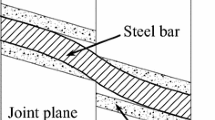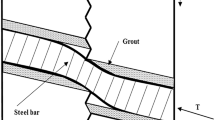Abstract
Bi-planar failure is one of the most common issues encountered in concealed bedding rock slopes (CBRSs). Fully grouted bolts are widely adopted to improve the stability of slopes and prevent failure due to their high efficacy and low cost. In this study, a bi-planar mechanical model is first established for the sliding body based on the interactions between active and passive blocks. The supporting forces supplied by fully grouted bolts are then introduced and limit equilibrium theory is used to analyze the stability of the bolted CBRSs. A parametric analysis is conducted to investigate the effects of varying the bolt angle (angle of the bolt with respect to the joint plane), bolt diameter, and bolt location on the stability of the CBRSs. Finally, comparisons are made between results obtained using the proposed method of analysis and discrete element modeling. The results obtained using the two different approaches are in good agreement. There is an optimal bolt angle that maximizes the stability of the bolted CBRSs–its value is approximately equal to the friction angle of the joint. The slope stability (and contribution made by the bolts) also increases with the diameter of the bolts used, the variation increasing according to a power function. The proposed method of analysis offers a sound basis for better understanding the mechanism by which fully grouted bolts reinforce such slopes and can be used as a useful design aid for protecting CBRSs against bi-planar failure.



















Similar content being viewed by others
Data availability
The authors confirm that the data supporting this research are available within the article [and / or] its references.
References
Alejano LR, Ferrero AM, Ramírez-Oyanguren P, Álvarez Fernández MI (2011) Comparison of limit-equilibrium, numerical and physical models of wall slope stability. Int J Rock Mech Min Sci 48(1):16–26
Bahrani N, Tannant DD (2011) Field-scale assessment of effective dilation angle and peak shear displacement for a footwall slab failure surface. Int J Rock Mech Min Sci 48(4):565–579
Cai Y, Jiang Y, Djamaluddin I, Iura T, Esaki T (2015) An analytical model considering interaction behavior of grouted rock bolts for convergence–confinement method in tunneling design. Int J Rock Mech Min Sci 76:112–126
Chen C, Peng Z (1996) The optimical reliability analysis of slope existing decisive joints in double-block failure pattern. J Cent South Univ Technol 27(4):387–391
Chen L, Zhang W, Zheng Y, Gu D, Wang L (2020) Stability analysis and design charts for over-dip rock slope against bi-planar sliding. Eng Geol 275:105732
Chen H, Zhu H, Zhang L (2021) Analytical solution for deep circular tunnels in rock with consideration of disturbed zone, 3D strength and large strain. Rock Mech Rock Eng 54(3):1391–1410
Chen H, Zhu H, Zhang L (2022a) A three-dimensional (3D) semi-analytical solution for the ultimate end-bearing capacity of rock-socketed shafts. Rock Mech Rock Eng 55(2):611–627
Chen H, Zhu H, Zhang L (2022b) An analytical approach to the ultimate bearing capacity of smooth and rough strip foundations on rock mass considering three-dimensional (3D) strength. Comput Geotech 149:104865
Cruden DM (2000) Some forms of mountain peaks in the Canadian Rockies controlled by their rock structure. Quatern Int 68:59–65
Fisher BR (2009) Improved characterization and analysis of bi-planar dip slope failures to limit model and parameter uncertainty in the determination of setback distances. The University of British Columbia, Vancouver, Canada (PhD Thesis)
Gharsallaoui H, Jafari M, Holeyman A (2020) Pile end bearing capacity in rock mass using cavity expansion theory. J Rock Mech Geotech Eng 12(5):1103–1111
Grasselli G (2005) 3D behaviour of bolted rock joints: experimental and numerical study. Int J Rock Mech Min Sci 42(1):13–24
Havaej M, Stead D, Eberhardt E, Fisher BR (2014) Characterization of bi-planar and ploughing failure mechanisms in footwall slopes using numerical modelling. Eng Geol 178(16):109–120
Havaej M, Wolter A, Stead D (2015) The possible role of brittle rock fracture in the 1963 Vajont Slide, Italy. Int J Rock Mech Min Sci 78(1):319–330
Huang R (2007) Large-scale landslides and their sliding mechanisms in China since the 20th century. Chin J Rock Mechan Eng 26(3):433–454
Huang S, Ding X, Zhang Y, Weng Y, Wu Y, Zhang C (2020) Field and numerical investigation of high wall stability with thin, steeply dipping strata in an underground powerhouse. Int J Geomech 20(6):4020055
Itasca Consulting Group Inc. (2004) UDEC (Universal Distinct Element Code). Version 4.0. Itasca International, Inc., Itasca, Minneapolis
Li B, Li T, Xu N, Dai F, Chen W, Tan Y (2018) Stability assessment of the left bank slope of the Baihetan Hydropower Station, Southwest China. Int J Rock Mech Min Sci 104:34–44
Liu CH, Li YZ (2017) Analytical study of the mechanical behavior of fully grouted bolts in bedding rock slopes. Rock Mech Rock Eng 50(9):2413–2423
Liu CN, Dong JJ, Chen CJ, Lee WF (2012) Typical landslides and related mechanisms in ali mountain highway induced by typhoon morakot: perspectives from engineering geology. Landslides 9(2):239–254
Lu C, Cai C (2019) Challenges and countermeasures for construction safety during the Sichuan-Tibet railway project. Engineering 5(5):833–838
National Standards Compilation Group of People’s Republic of China, GB 50010-2010 (2015) Code for design of concrete structures. China Architecture and Building Press, Beijing, China
National Standards Compilation Group of People’s Republic of China, GB 50330-2013 (2013) Technical code for building slope engineering. China Architecture and Building Press, Beijing, China
National Standards Compilation Group of People’s Republic of China, GB/T 50218-2014 (2014) Standard for engineering classification of rock masses. China Planning Press, Beijing, China
Ning YJ, An XM, Ma GW (2011) Footwall slope stability analysis with the numerical manifold method. Int J Rock Mech Min Sci 48(6):964–975
Oreste PP, Cravero M (2008) An analysis of the action of dowels on the stabilization of rock blocks on underground excavation walls. Rock Mech Rock Eng 41(6):835–868
Pellet F, Egger P (1996) Analytical model for the mechanical behaviour of bolted rock joints subjected to shearing. Rock Mech Rock Eng 29(2):73–97
Ranjbarnia M, Rashedi MM, Dias D (2022) Analytical and numerical simulations to investigate effective parameters on pre-tensioned rockbolt behavior in rock slopes. Bull Eng Geol Environ 81(2):74
Siad L (2001) Stability analysis of jointed rock slopes reinforced by passive, fully grouted bolts. Comput Geotech 28(5):325–347
Siad L, Megueddem M (1998) Stability analysis of jointed rock slope. Mech Res Commun 25(6):661–670
Song D, Bai Y, Chen XQ, Zhou GG, Choi CE, Pasuto A, Peng P (2022) Assessment of debris flow multiple-surge load model based on the physical process of debris-barrier interaction. Landslides 19(5):1165–1177
Sun C, Chen C, Zheng Y, Zhang W, Liu F (2019) Numerical and theoretical study of bi-planar failure in footwall slopes. Eng Geol 260:105234
Sun C, Chen C, Zheng Y, Xia K (2020) Limit-equilibrium analysis of stability of footwall slope with respect to biplanar failure. Int J Geomech 20(1):04019137
Sun C, Chen C, Zheng Y, Pan Y, Zhang Y (2021) Analysis of stability of concealed cataclinal slopes with talus deposits accumulated at their toes with respect to biplanar failure. Int J Geomech 21(11):04021219
Sun C, Chen C, Zheng Y, Xia K, Ren Z (2022) Assessing the stability of dip slopes based on analyzing the stress at a key point on the sliding surface. Int J Geomech 22(9):04022152
Tan CH (2016) Difference solution of passive bolts reinforcement around a circular opening in elastoplastic rock mass. Int J Rock Mech Min Sci 81:28–38
Wang FW, Zhang YM, Huo ZT, Matsumoto T, Huang BL (2004) The July 14, 2003 Qianjiangping landslide, three gorges reservoir, China. Landslides 1(2):157–162
Wu R, Zhang Y, Guo C, Yang Z, Tang J, Su F (2020) Landslide susceptibility assessment in mountainous area: a case study of Sichuan-Tibet railway, China. Environ Earth Sci 79(6):1–16
Xia K, Chen C, Wang T, Zheng Y, Wang Y (2022) Estimating the geological strength index and disturbance factor in the Hoek-Brown criterion using the acoustic wave velocity in the rock mass. Eng Geol 306:106745
Yin Y, Sun P, Zhang M, Li B (2011) Mechanism on apparent dip sliding of oblique inclined bedding rockslide at jiweishan, chongqing, china. Landslides 8(1):49–65
Zhao L, Li D, Tan H, Cheng X, Zuo S (2019) Characteristics of failure area and failure mechanism of a bedding rockslide in Libo County, Guizhou, China. Landslides 16(7):1367–1374
Zheng Y, Chen C, Liu T, Song D, Meng F (2019) Stability analysis of anti-dip bedding rock slopes locally reinforced by rock bolts. Eng Geol 251:228–240
Zheng Y, Chen C, Liu T, Ren Z (2021) A new method of assessing the stability of anti-dip bedding rock slopes subjected to earthquake. Bull Eng Geol Env 80(5):3693–3710
Acknowledgements
We would like to acknowledge the reviewers and the editor for their valuable comments and suggestions.
Funding
This paper was financially supported by the Natural Science Foundation of Hubei Province, China (Grant No. 2021CFB226), National Natural Science Foundation of China (Grant Nos. 12102443 and 42207235), and Natural Science Foundation of Hunan Province, China (Grant No. 2022JJ40371).
Author information
Authors and Affiliations
Corresponding author
Ethics declarations
Conflict of interest
The authors declare no competing interests.
Rights and permissions
Springer Nature or its licensor (e.g. a society or other partner) holds exclusive rights to this article under a publishing agreement with the author(s) or other rightsholder(s); author self-archiving of the accepted manuscript version of this article is solely governed by the terms of such publishing agreement and applicable law.
About this article
Cite this article
Sun, C., Chen, C., Zhang, W. et al. Stability of bolt-supported concealed bedding rock slopes with respect to bi-planar failure. Bull Eng Geol Environ 82, 104 (2023). https://doi.org/10.1007/s10064-023-03131-5
Received:
Accepted:
Published:
DOI: https://doi.org/10.1007/s10064-023-03131-5




